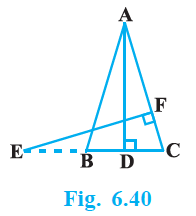
Given, ABC is an isosceles triangle.
AB = AC
$ \angle ABD = \angle ECF$
In ΔABD and ΔECF
$ \angle ADB = \angle EFC $(Each 90°)
$ \angle BAD = \angle CEF$ (Already proved)
ΔABD ~ ΔECF (using AA similarity criterion)

Given
ΔABC and ΔPQR, AB, BC and median AD of ΔABC are proportional to sides PQ, QR and median PM of ΔPQR
$\dfrac{AB}{PQ} = \dfrac{BC}{QR} = \dfrac{AD}{PM}$
We have to prove: ΔABC ~ ΔPQR
As we know here
$\dfrac{AB}{PQ} = \dfrac{BC}{QR} = \dfrac{AD}{PM}$
or $\dfrac{AB}{PQ} = \dfrac{(\dfrac{1}{2})BC}{(\dfrac{1}{2})QR} = \dfrac{AD}{PM}$
$\dfrac{AB}{PQ} = \dfrac{BC}{QR} = \dfrac{AD}{PM}$ (D is the midpoint of BC. M is the midpoint of QR)
ΔABD ~ ΔPQM [SSS similarity criterion]
$\angle ABD = \angle $PQM [Corresponding angles of two similar triangles are equal]
$\angle ABC = \angle PQR$
In ΔABC and ΔPQR
$\dfrac{AB}{PQ} = \dfrac{BC}{QR}$ ………………………….(i)
$\angle ABC = \angle PQR$ ……………………………(ii)
From equation (i) and (ii), we get
ΔABC ~ ΔPQR [SAS similarity criterion]
Given,
D is a point on the side BC of a triangle ABC such that $\angle ADC = \angle BAC$
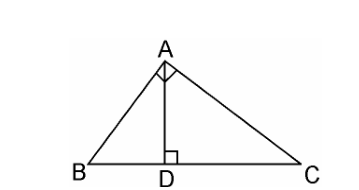
In ΔADC and ΔBAC
$\angle ADC = \angle BAC$ (Already given)
$\angle ACD = \angle BCA$ (Common angles)
ΔADC ~ ΔBAC (AA similarity criterion)
We know that corresponding sides of similar triangles are in proportion
$\dfrac{CA}{CB} = \dfrac{CD}{CA}$
$CA^2$ = CB.CD
Hence proved
Given,
Two triangles ΔABC and ΔPQR in which AD and PM are medians such that
$\dfrac{AB}{PQ} = \dfrac{AC}{PR} = \dfrac{AD}{PM}$
We have to prove, ΔABC ~ ΔPQR
Let us construct first
Produce AD to E so that AD = DE. Join CE, Similarly produce PM to N such that PM = MN, also Join RN.
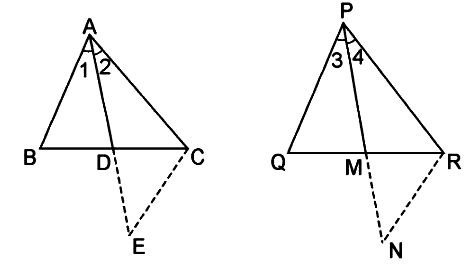
In ΔABD and ΔCDE, we have
AD = DE [By Construction.]
BD = DC [Since, AP is the median]
and, $\angle ADB = \angle CDE$ [Vertically opposite angles]
ΔABD ≅ ΔCDE [SAS criterion of congruence]
AB = CE [By CPCT] …………………………..(i)
Also, in ΔPQM and ΔMNR
PM = MN [By Construction]
QM = MR [Since, PM is the median]
and, $\angle PMQ = \angle NMR $[Vertically opposite angles]
ΔPQM = ΔMNR [SAS criterion of congruence]
PQ = RN [CPCT] ………………………………(ii)
Now, $\dfrac{AB}{PQ} = \dfrac{AC}{PR} = \dfrac{AD}{PM}$
From equation (i) and (ii)
$\dfrac{CE}{RN} = \dfrac{AC}{PR} = \dfrac{AD}{PM}$
$\dfrac{CE}{RN} = \dfrac{AC}{PR} = \dfrac{2AD}{2PM}$
$\dfrac{CE}{RN} = \dfrac{AC}{PR} = \dfrac{AE}{PN}$ [Since 2AD = AE and 2PM = PN]
ΔACE ~ ΔPRN [SSS similarity criterion]
Therefore,$ \angle 2 = \angle 4$
Similarly,$ \angle 1 = \angle 3$
$\angle 1 + \angle 2 = \angle 3 + \angle 4$
$\angle A = \angle P$ …………………………………………….(iii)
Now, in ΔABC and ΔPQR, we have
$\dfrac{AB}{PQ} = \dfrac{AC}{PR}$ (Already given)
From equation (iii)
$\angle A = \angle P$
ΔABC ~ ΔPQR [ SAS similarity criterion]
Given,
Length of the vertical pole = 6m
Shadow of the pole = 4 m
Let Height of tower = h m
Length of shadow of the tower = 28 m
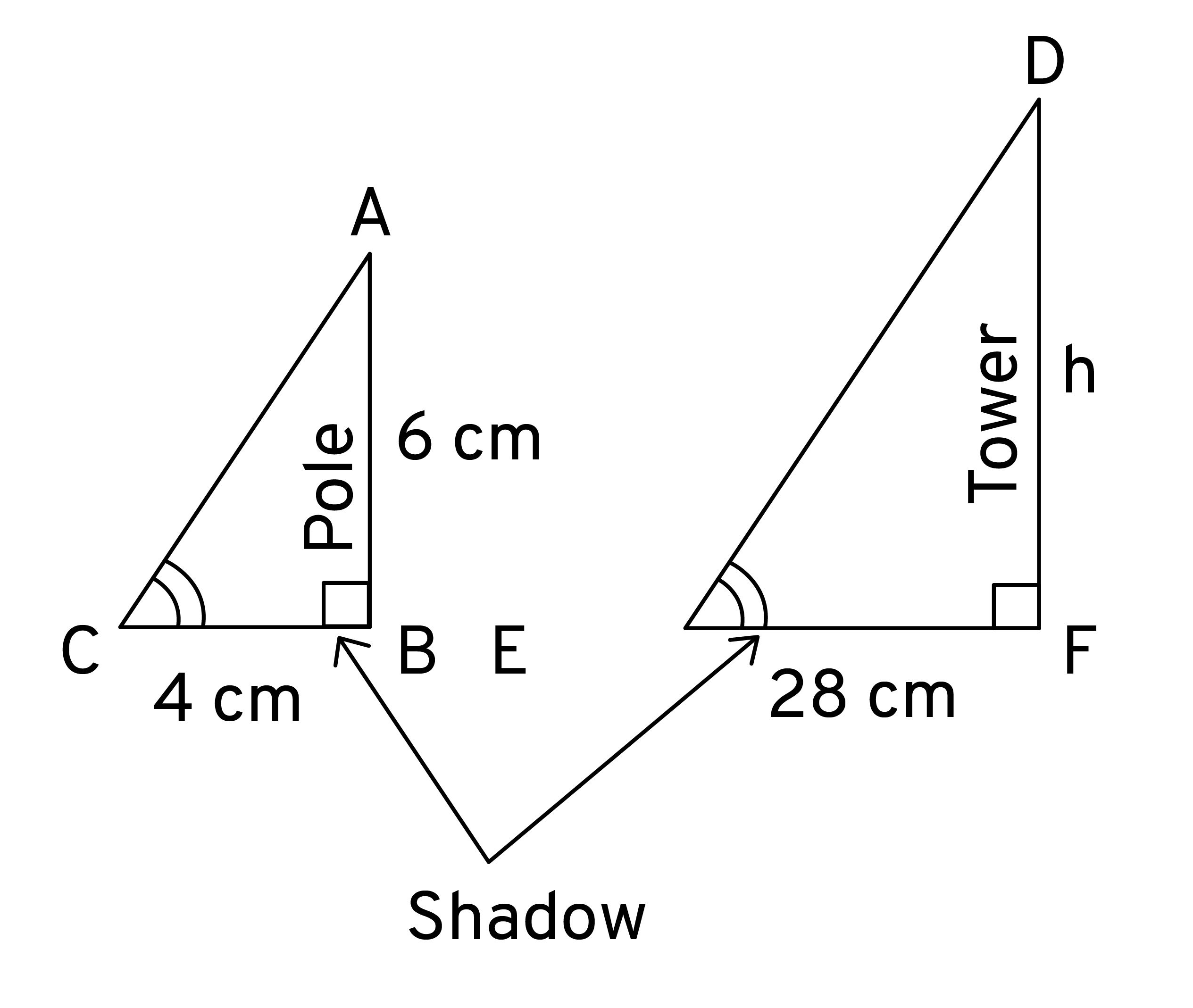
In ΔABC and ΔDEF
$\angle C = \angle E$ (angular elevation of sum)
$\angle B = \angle F = 90°$
ΔABC ~ ΔDEF (AA similarity criterion)
$\dfrac{AB}{DF} = \dfrac{BC}{EF}$ (If two triangles are similar corresponding sides are proportional)
$\dfrac{6}{h} = \dfrac{4}{28}$
$h = \dfrac{(6×28)}{4}$
h = 6 × 7
h = 42 m
Hence, the height of the tower is 42 m.
Given, ΔABC ~ ΔPQR
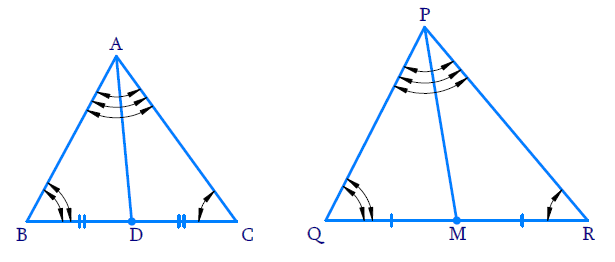
We know that the corresponding sides of similar triangles are in proportion.
$\dfrac{AB}{PQ} = \dfrac{AC}{PR} = \dfrac{BC}{QR} $……………………………(i)
Also, $\angle A = \angle P, \angle B = \angle Q, \angle C = \angle R $………….…..(ii)
Since AD and PM are medians, they will divide their opposite sides.
$BD = \dfrac{BC}{2}$ and $QM = \dfrac{QR}{2} $……………..………….(iii)
From equations (i) and (iii), we get
$\dfrac{AB}{PQ} = \dfrac{BD}{QM} $……………………….(iv)
In ΔABD and ΔPQM
From equation (ii), we have
$\angle B = \angle Q$
From equation (iv), we have
$\dfrac{AB}{PQ} = \dfrac{BD}{QM}$
ΔABD ~ ΔPQM (SAS similarity criterion)
$\dfrac{AB}{PQ} = \dfrac{BD}{QM} = \dfrac{AD}{PM}$
